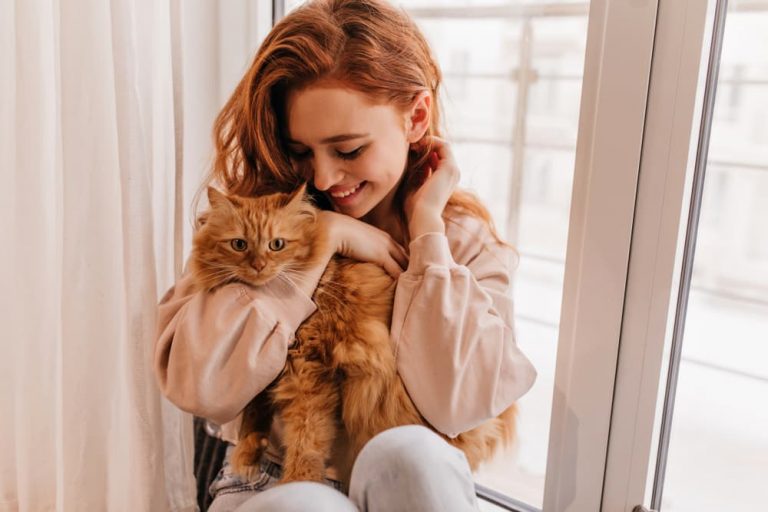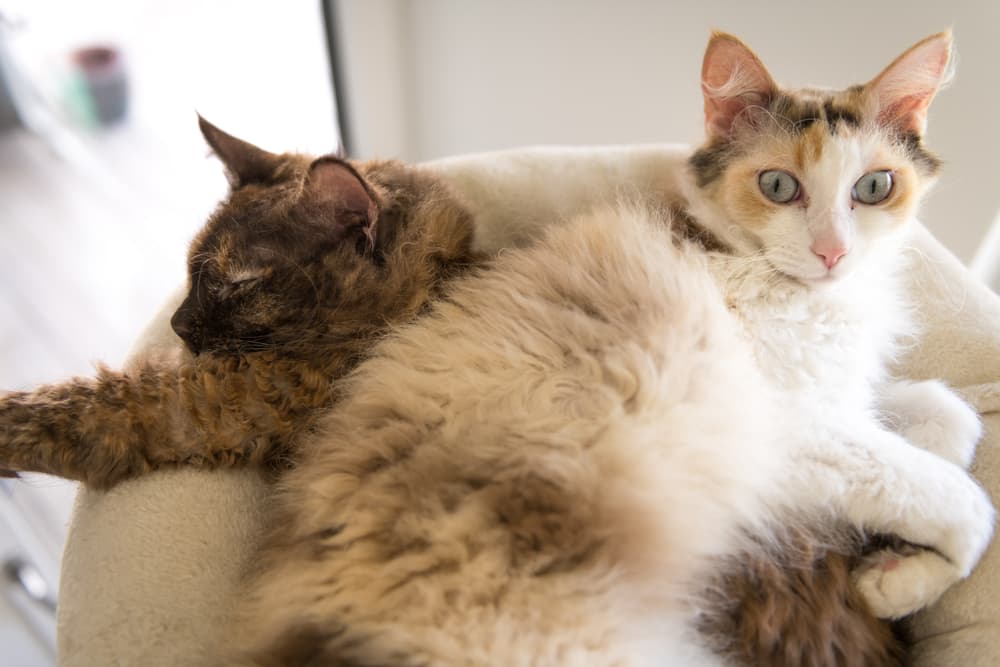9 Curly Haired Cat Breeds With Looping Locks

Cat coats span the spectrum. From fabulously floofy to super sleek to barely there (we’re looking at you, Sphynx), our feline friends enjoy quite the range in the wardrobe department. In fact, some cats even have curly coats.
Curly haired cat breeds are as unusual as they are adorable. Read on for everything you need to know about these well-coiffed kitties, from breed characteristics to grooming tips.
Why Do Some Cat Breeds Have Curly Hair?

Some cats have curly hair for the same reason some people have curly hair: genetics.
“The curly coat is a result of a natural genetic mutation,” says Dr. Jamie Whittenburg, director of Kingsgate Animal Hospital in Lubbock, Texas. “Curly coats are fairly rare in cats but are selected for the genetic mutation, and then bred together to continue it.”
Curly coats occur in a variety of lengths and textures. The hair can be long or short. Some curly haired cat breeds lack an undercoat, leading to a sparse appearance.
9 Curly Haired Cat Breeds
- Selkirk Rex
- Devon Rex
- Cornish Rex
- LaPerm
- Ural Rex
- German Rex
- Tasman Manx
- Tennessee Rex
- Skookum
Officially speaking, The Cat Fanciers’ Association (CFA) only recognizes four breeds of cats with curly hair: Selkirk Rex, Devon Rex, Cornish Rex, and LaPerm. However, there are also a handful of unrecognized cat breeds with curly hair.
Here are some amazing curly haired cat breeds to read up on:
Selkirk Rex

If you can’t decide between a cat or a teddy bear, this is your kitty. The Selkirk Rex traces its origins to an unusual looking shelter kitten named Miss DePesto, who was adopted by a curious Persian breeder in Montana in the 1980s. When bred with a Persian, three of Miss DePesto’s kittens had their mother’s curly coat, and a breed was born.
Big-boned and fluffy, the Selkirk Rex has plush, dense, curly hair, as well as curly whiskers. Coats can be long or short, with long coats having the most noticeable waves. A single copy of the genetic variant that causes the Selkirk Rex coat results in loosely waved hair, while two copies produce a tighter curl.
The Selkirk Rex is known to be affectionate, which is good news for everyone who can’t resist snuggling a teddy kitty.
Devon Rex

Originating in Devonshire, England in the 1950s, the Devon Rex is an unusual looking cat by all measures. Elfin in appearance, the breed is distinguished by large eyes, high cheekbones, low, prominent ears, and soft, short, rippled fur. The Devon’s distinctively wavy coat can be a wide variety of colors and patterns.
Surprisingly, the Devon Rex’s one-of-a-kind personality overshadows its unique appearance. Affectionately referred to by breed enthusiasts as “a monkey in a cat suit,” the Devon is known to be extremely playful, affectionate, people-oriented, and active. Skilled jumpers, these athletic cats enjoy finding unusual hiding places, and like to spend time wrapped around their humans’ shoulders.
Cornish Rex

The Cornish Rex is another curly haired cat breed with roots in the English countryside. As a curly kitten, Kallibunker was clearly different from his barn cat siblings. Kallibunker was bred to produce wavy coated kittens, which were then bred with Burmese, Siamese, and British domestic shorthair cats. The result? An exotic new breed with large, bat-like ears and incredibly soft, curly fur.
The Cornish Rex’s fine, short curls fall in “Marcel waves” – a term usually reserved for the glamorous Old Hollywood hairstyle – and are velvety soft. Although the breed sometimes appears on lists of “hypoallergenic” cats, the Cornish Rex does indeed shed (although minimally) and produces allergens.
LaPerm

In the 1980s, the owner of a farm in Oregon noticed that many of the barn cats had curly hair. She began to breed them selectively, resulting in a striking new wavy cat breed now known as the LaPerm.
LaPerm cats can have a wide range of curls, from soft waves to tight ringlets to long corkscrews. Longhair LaPerms have full, flouncy, curled tails, while the shorthair variety has a “bottlebrush” tail. A LaPerm’s coat may change density and curl patterns throughout their lifetime, and many LaPerms have distinctive “parts” down their back fur.
Ural Rex

Recognized by the German-based World Cat Federation in 2006, the Ural Rex is a relatively new breed defined by its soft, silky, gently curled coat. Although the Ural Rex appears similar to other Rex breeds, a 2020 study found that its curly coat has a unique genetic variant not present in other breeds. Rarely found outside of their native Russia, the Ural Rex’s oversized eyes and sweet personality have earned the breed plenty of fans at home.
German Rex

The German Rex is a rare curly fur cat breed formally recognized by the International Cat Federation, which bills itself as the “United Nations of Cat Federations.” Distinguished by its waved, velvety coat and short, curly whiskers, the German Rex also boasts lovably oversized ears.
Tasman Manx
Why stop at one highly unusual characteristic? The Tasman Manx is notable for having two rare qualities: a curled coat and an absent tail. Recognized by New Zealand Cat Fancy, the Tasman Manx is native to Australia and New Zealand, borrowing its name from the Tasman Sea. Like all Manx cats, the Tasman is either tailless – a quality known in cat breeding circles as “rumpy” – or almost tailless, aka “stumpy.” (Per the breed’s official standards, “both rumpy risers and stumpys are acceptable on the show bench.”) In addition to a soft, rippled coat, the Tasman also has kinked whiskers.
Tennessee Rex
Originating in the Tennessee Valley in 2004, the Tennessee Rex is an all-American breed newly recognized by The International Cat Association (TICA). Curly coated from birth, these large cats have lustrous fur with a “satin-like” appearance that almost appears to shimmer in the light.
Skookum
The Skookum cat is a so-called “dwarf” breed developed in the 1990s by crossing curly-haired LaPerms with short-legged Munchkin cats. While striking, Skookums and Munchkins are controversial. Although recognized by TICA, most cat registries and cat associations, including the International Cat Federation, consider it unethical to breed Munchkins due to health and mobility concerns.
Curly Haired Cat Breeds: Grooming and Care Tips

Like all feline friends, curly haired cats benefit from brushing to keep their coats and skin healthy.
“Cats with longer curly hair likely need regular, gentle brushing at least a couple of times a week to help prevent any matting,” says Janet Cutler, PhD, a Certified Applied Animal Behaviorist (CAAB) and owner of Landmark Behavior. “Shorter curly hair may require the occasional brushing, or simply brushing with your hand.”
Additionally, some curly haired cat breeds with sparse coats can be at risk of sunburn, notes Cutler, especially on their ears. These cats should have limited outdoor exposure during the sunniest times of day. UV-blocking window films can be helpful for protecting sunbathing kitties inside.
If you choose to purchase a curly haired cat, it’s important to select a responsible, registered breeder who ensures the health and welfare of the parent cats and kittens. In particular, Selkirk Rex cats are prone to kidney disease, and these cats should be tested before breeding, notes Cutler.
Every breed (and cat!) is unique, so be sure to check in with your veterinarian about any health or grooming concerns to keep your curly-coated friend looking and feeling their best.









